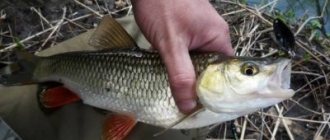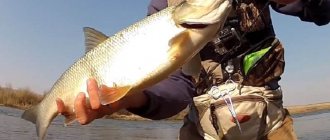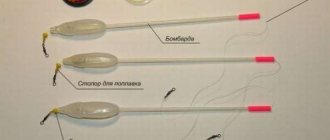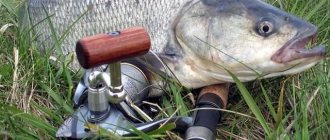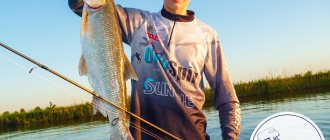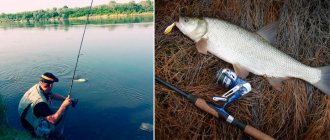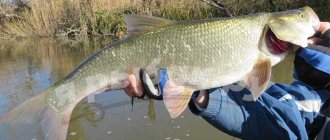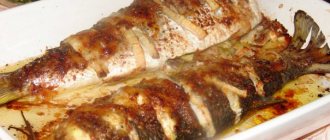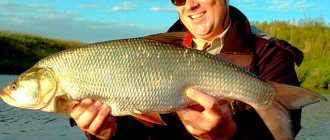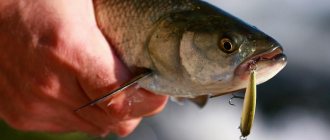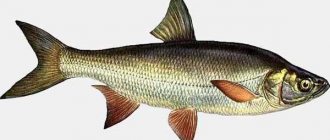The uniqueness of the asp
Asp, aka river pirate, aka grip, sheresper, horse, whiteness, whiteness. And he deserved all these nicknames. A pirate because he is constantly in an active search for food and it is almost impossible for small fish to hide from his rapid attack. Grip, because, despite the lack of teeth, even a relatively large fish will not be able to escape from its mouth. It received the name sheresper because it likes to spread out all its fins, and the horse because, when attacking prey, it jumps high out of the water and hits its surface with its powerful tail, trying to stun its victim. Well, whiteness and shine - for its unique color. Moreover, all these names are telling and only from them can the fisherman have a good idea of what kind of opponent he will have to fight on the rifts, near steep banks, on the current, not far from hydraulic structures and in other promising places.
You can read about the biological characteristics and habits of the asp here.
Where to find asp
The habitats of a river pirate depend directly on the way he hunts. Possessing very good eyesight, in clean running water he sees a cluster of potential victims from a great distance, and this is the main condition why he not only does not like stagnant and muddy water, but simply avoids it. Therefore, asp does not live in small swampy ponds, in rivers with slow flows, peat and other banks that color the water, and where there is a thick layer of silt at the bottom.
But in wide rivers with a pronounced current, in large reservoirs not far from the flooded bed, he feels quite comfortable. But even here it is not distributed throughout the entire water area, preferring those places where the water is cleaner and more saturated with oxygen. All summer, after spawning, the sheresper robbers below the rifts, if any, on shallows with a rocky, sandy or pebble bottom, near steep banks, in eddies formed by the piles of bridges, dams and other structures, in places where flooded trees accumulate. It is here that flocks of small chubs, minnows, bleak and other favorite prey of this river pirate accumulate.
In spring, you should look for asp under branches of trees and bushes hanging over the water. Here he not only hides in the shade from direct sunlight, but also waits for a careless cockchafer, dragonfly, grasshopper or some other tasty insect to fall into the water. Sometimes he doesn’t even wait, but jumps out of the water. The speed that this fish can develop allows it to grab a low-flying insect.
Small fish, insects, crustaceans and worms are the main food of the asp
When to catch
The main asp fishing occurs, of course, in the summer. At this time, he is most active, feeds almost all daylight hours and only sinks to the bottom at night to rest and gain strength, so that with the first rays of the sun he can begin his predatory raids again.
However, experienced fishermen can successfully catch asp in winter. The sheresper does not fall into continuous hibernation. It simply drops into wintering pits and if you know where such a pit is located, a half-asleep pirate can be quite tempted to bite. This applies to bodies of water covered with ice. But there are canals near hydroelectric power stations and other technical structures that do not freeze in the winter and where asp live. Then a spinning rod equipped with jig tackle is quite suitable for catching it. Of course, the pike perch bites more often in such conditions, but the sheresper can also react.
Jig tackle in winter can tempt an asp to attack
Preparing equipment for catching asp using a bombard
In April, the pirate's predatory instincts begin to awaken. But he is not in a hurry to the surface yet, even if the ice has already melted, but he is already making forays not far from his wintering hole.
After the water warms up to a temperature of 9–12 degrees, the asp’s bite takes on a completely unpredictable character. He will not refuse a fry swimming past, but during this period he is busy with other more important things. It's time for spawning. To do this, you need to find a mate and a favorable place. Usually these are small tables with a rocky bottom, where up to several pairs of asps often gather.
After spawning, the river pirate comes to his senses for some time and after a couple of weeks begins to lead his usual way of life. She leaves her temporary friend, constantly patrols her favorite area of the reservoir and actively feeds. This continues all summer. In August and September, even more active zhor is observed. The fish begins to prepare for winter and in the fall, or rather at its beginning, feeds more intensively. And after the water cools, it descends to its wintering holes and loses activity until next spring.
Where and what to catch in the game Real Fishing
In the Real Fishing , fish, as the name of the application emphasizes, are found in their inherent ecological zones, so it will not be possible to catch a piranha in a forest river. Here is a little hint for Real Fishing players, where and what to catch.
Let's start with Real Fishing for crucian carp:
- Found in crucian carp pond (depth 260) and forest lake (150 centimeters).
- Caught with semolina or bait.
- It goes best during the day.
Real Sturgeon Fishing:
- Volga, depth 390-475 centimeters.
- Near the shore it is fishing for a worm, in the distance only for a mollusk.
- Any time of the day except night.
Source
What to fish with
Asp, like most other fish, can be caught with almost any tackle. They catch it with a float rod, with a retractable leash, and with mugs. In this case, either live bait or large insects are used as bait if fishing occurs in the spring. But the first place in terms of catchability is, of course, taken by spinning tackle for asp. And if in late autumn, winter and early spring it is a jig, then in the summer, during the period of greatest pirate activity, surface baits are used, since it is useless to look for it in the depths.
Popper
Despite the fact that the asp is not found where this purely surface bait was invented, it seems to be specially created to catch the sheresper. With proper retrieving, during which the spinner must not only reel in the line with the reel and take the necessary pauses, but also twitch the tip of the rod, the popper begins to “spit.” A special recess in its front part allows it to do this, which is very attractive to predatory fish. In relation to asp, when using a popper, you need to remember that you should not choose particularly large and wide baits.
Popper is a purely surface bait.
Devonian
But the creators of this fishing helicopter, on the contrary, claim that they created the bait exclusively for asp fishing. Devons are heavy enough to make long casts without difficulty, which is very important when catching asp. It is made of polished lead and with its shine will definitely attract the attention of an active predator. During wiring, it creates not only attractive breakers, but also a seductive buzzing sound. The only inconvenience is that it twists the line. You can avoid this by placing a regular swivel in front of the bait. However, experienced fishermen use another Devon with reverse rotation of the blades instead.
Devon is a catchy but expensive bait
Turntables
The asp also responds well to spinners with central loading. They are perfect for him. The wiring should be fast, but not uniform. The method called “on the verge of stopping rotation” is absolutely not suitable here.
Asp turntables must have a central load
Wobblers and walkers
This type of bait is not used very often, but if chosen correctly it can be a solution to the problem. The main thing is to keep them on the surface while wiring. The second necessary condition is that the wobbler must be driven, similar in appearance to bleak or minnow and not too large in size. It is used most often when fishing from a boat at short distances, since long casting is problematic due to its low weight.
Oscillators
Oscillating spoons are most often used to catch asp. The main condition when choosing them is purity and shine. In most cases, river pirates are not interested in wide fishtails, since they do not resemble his potential prey. Shine is also a sign of potential prey. Spoon baits are good both when fishing from a boat and when casting long distances from the shore.
A narrow spoon is one of the most catchy baits for asp
Castmaster
But most fishermen put the castmaster in first place, rightly believing that these are the best baits for fishing for asp. They fly far and accurately. They do not require particularly delicate handling or unique wiring skills. And with all this, there are no more seductive lures for the asp. They are the ones who most remind him of his potential victims, so he will never miss a castmaster floating by, even if he is inactive at that moment.
Castmaster – most often used for asp fishing
Jig lures
This method only works in early spring and late autumn, when the asp prefers to lead a bottom-dwelling, semi-dormant lifestyle. And there is one little secret. A regular jigging step will be more likely to seduce pike perch, simply because it is more active at a given time. But as soon as you increase the number of turns of the reel from two or three to four or five and make pauses longer by a couple of seconds, the pike perch ceases to be interested in such wiring, and the asp, on the contrary, becomes excited and attacks.
What bait to use
Just like in reality, to get a catch, you need to be well prepared. You will need a set of tackle, fishing rods, hooks and other equipment. You also need to choose bait.
To purchase everything you need, visit the game store. There you can buy new equipment and sell old equipment so that it does not interfere with your hike. There are more than a hundred different products, and with each update of the game their number is constantly growing. So fans of shopping have somewhere to roam. And real fishing professionals will be able to find everything they need to succeed in the game.
Depending on the type of reservoir, different types of fish live in it. There are more than 50 types in the game. And each of them, as in real life, has its own habits, character, and prefers different depths. And you need to catch them with various baits.
Each inhabitant of a reservoir requires a special approach and different bait. Starting equipment will not help you catch a large and valuable specimen - neither the fishing rod, nor the fishing line, nor the hook will hold up. And big fish won’t bite at the first bait they come across.
The interactive guide, which is integrated into the game, will help you choose the best bait for each case. There are also tips on fishing methods.
The choice of bait depends not only on the type, but also on the type of gear, the characteristics of the reservoir and even the time of year. And it should be taken into account that, just like in a real store, the necessary bait is not always available! The store offers:
- larvae of various species;
- insects;
- gastropods;
- shellfish;
- crustaceans and shrimp;
- frogs.
Another type of bait is live bait, but you have to catch it yourself.
Baits can be universal or specialized, exclusive, designed for a specific breed. The universal ones include maggots and bloodworms, as well as the larvae of various insects. Various fish are caught with it.
Tackle
The general equipment depends on how we fish. The most popular gear for asp fishing is a spinning rod and a float rod.
Spinning
You can catch asp with a spinning rod all summer long. Depending on the size and topography of the reservoir, it is possible to catch a sheresper from the shore, but more often they go out to hunt for it by boat. This provides some benefits to the angler. A sharp-sighted asp is not so afraid of a foreign object located on the water. But when he sees a human figure on the shore, he will prefer to move to another place. For this reason, on a boat you can get much closer to the hunting river pirate and in this case a particularly long spinning rod is not required. A 2–2.5 meter long stick with a spinning reel and a good set of baits and spinners will ensure exciting and productive fishing on the Volga, the Dnieper, and in Europe. Monoline and braid work equally well, so this choice is a matter of personal preference.
When fishing from the shore, you will need a rod 2.5–3 meters long, because you will have to cast the lure at least 60 meters. Although, if you have experience, it is quite possible to use the tactic of floating the bait to the desired location. This trick, of course, will not work with spinners, but with some types of wobblers, walkers, poppers and flies it is quite effective. The bait is cast a little downstream and floated on an open reel to the asp’s camp. The method requires very precise casting and even more precise calculation of the current, which should bring the bait right under the nose of the shereper.
Float tackle
This method of catching asp is most effective in the spring, when cockchafers, dragonflies and other insects fall from tree branches and bushes into the water. And you need to catch sheresper in precisely such places. Firstly, you can camouflage yourself well on the shore among the same bushes and carefully float the bait directly under the branches. Secondly, you can collect bait right here.
The length of the rod directly depends on the fishing location, but it is better not to take anything shorter than 3.5 meters. There is also no need to use a fishing line thicker than 0.3 mm. The asp will see her and will never dare to attack. You can use cockchafers, grasshoppers, dragonflies, other large insects and even small frogs as bait.
Choosing gear for asp fishing
The asp is a very cautious fish and has excellent eyesight, so it is caught at a distance. When swallowing bait, this large freshwater fish can offer strong resistance. Tools for such fishing must be adapted to long casts, have strength and reliability sufficient to strongly repel fish weighing several kilograms.
Pay attention to the information on how to deliciously cook asp in the oven.
Spinning
This tackle is considered ideal for asp fishing, especially in summer. During this period, the sheresper bites well on spinning baits. The rod size chosen is 2.7–3.3 m. A two-handed spinning rod with a length of about 3 m and a high-speed inertial reel is considered a good choice. The latter should have good strength and size 3000–4000. Take a monofilament line with a cross section of 0.25 mm or a braided line with a dense structure. The equipment must include rings and a float.
Float tackle
The float is chosen to be discreet, in the form of a transparent ball. Then the asp will mistake it for a water bubble. It is best to buy a water-filled option. The float rod must be at least 3.6 m long with a monofilament line with a diameter of 0.2–0.3 mm.
Did you know? Bombarda (sbirulino) was invented relatively recently - in the 20th century by the sports team “Team Daiwa” in Italy for trout fishing. She came to Russia only 10 years ago.
The reel chosen is inertia-free, suitable for long casts. The distance from live bait or bait should be at least 1 m. Baits are attached to hooks No. 7–10 (depending on the size of the bait).
Bombard
It is convenient to use such equipment near snags, stones, and holes, since it is less likely to cling to obstacles. Sbirulino (bombard) is the most popular type of “heavy” float used with a floating wobbler or spinner.
Here you can learn how to cook cold and hot smoked asp.
It allows you to cast bait at a distance of up to 60 m. For asp, bombards weighing 25–35 g are usually used. As a fishing rod, you can take a 3 m long spinning rod with a spinning reel and a 0.16 mm braided cord. The leashes are taken from monofilament fishing line 0.2–0.3 mm, 1–1.5 m long.
Fly fishing
This fishing method has been used since the emergence of insects in small rivers overgrown with grasses and with fast currents. Baits are taken lightly - insects or streamers with flies.
We suggest that you familiarize yourself with information on how to pickle asp at home.
The rod chosen is strong and light, 2.5–3 m long from 2–3 legs. It must have rings that can withstand the load of playing large fish. It is better to choose a medium or fast action rod type, as they are suitable for different bodies of water. The bait is thrown as far as possible across the current, somewhat away from the splash of the fish.
To the boat
This method is also called “water snake”. It allows you to quietly float bait downstream for wary fish. The “ship” is a board made of light wood, surrounded on one side by a lead plate. Some people make it from two wooden plates connected with a pin. It is equipped with leashes made of fishing line, which are brought together into one and attached with a swivel to the fishing line of the rod.
Important! The bait is thrown into the upper layers of water in the spring and summer, and in the fall it is pulled along the bottom.
1-3 leashes with hooks and bait are tied to the main fishing line at a distance of 2–3 m of such a boat. The coil used is large in size and inertial. A short hard spinning rod is used as a fishing rod. The length of the fishing line should be 50–100 m. Insects are usually used as bait.
Main
When going fishing to catch an asp, you must remember that this predator is strong, swift, active and very careful. Excellent vision allows him not only to see prey, but also to notice danger at a very great distance. The fisherman must do everything in his power so that the sheresper does not suspect a trick. Therefore, it is better to catch it from the shore either at a long distance or from cover.
Finding a robber asp is not difficult. Characteristic loud bursts will indicate its presence and activity. This usually happens at shallow depths, below rifts, in places with a pronounced reverse current, under branches of bushes and trees hanging over the water. In places where fry or schools of small fish usually accumulate.
It is necessary to determine what the asp is currently being caught at at a given point using an experimental method. The river pirate is picky and can change his preferences several times within a couple of hours. Carrying an arsenal of baits with you is not a collection, but a necessity. But you won’t have to carry the bait. Like any other predator, you can lure an asp only by skillfully playing bait.
The splash casting method works well. Having noticed at what point the asp made another stunning jump, you need to immediately throw the bait there. If it splashes down at some distance from the center of the diverging circles, it’s okay - the sheresper never stands in one place. The main thing is to start retrieving immediately so that the bait does not have time to go to depth and stays almost on the surface.
Knowing all these subtleties and nuances, you can passionately and effectively catch this beautiful and strong predator, receiving indescribable pleasure from defeating a worthy opponent. And if you also have culinary talent, then you can cook tender sheresper meat in such a way that it will become a real decoration for the holiday table.
What bait to use
Just like in reality, to get a catch, you need to be well prepared. You will need a set of tackle, fishing rods, hooks and other equipment. You also need to choose bait.
To purchase everything you need, visit the game store. There you can buy new equipment and sell old equipment so that it does not interfere with your hike. There are more than a hundred different products, and with each update of the game their number is constantly growing. So fans of shopping have somewhere to roam. And real fishing professionals will be able to find everything they need to succeed in the game.
Depending on the type of reservoir, different types of fish live in it. There are more than 50 types in the game. And each of them, as in real life, has its own habits, character, and prefers different depths. And you need to catch them with various baits.
Each inhabitant of a reservoir requires a special approach and different bait. Starting equipment will not help you catch a large and valuable specimen - neither the fishing rod, nor the fishing line, nor the hook will hold up. And big fish won’t bite at the first bait they come across.
The interactive guide, which is integrated into the game, will help you choose the best bait for each case. There are also tips on fishing methods.
The choice of bait depends not only on the type, but also on the type of gear, the characteristics of the reservoir and even the time of year. And it should be taken into account that, just like in a real store, the necessary bait is not always available! The store offers:
- larvae of various species;
- insects;
- gastropods;
- shellfish;
- crustaceans and shrimp;
- frogs.
Another type of bait is live bait, but you have to catch it yourself.
Baits can be universal or specialized, exclusive, designed for a specific breed. The universal ones include maggots and bloodworms, as well as the larvae of various insects. Various fish are caught with it.
